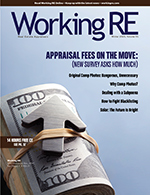 |
“One of the best courses that I have had in 17 years!” -Amy H
>> OREP E&O |
Editor’s Note: Take the NEW 2021 Appraiser Fee Survey online now at WorkingRE.com/2021survey.
Solar: The Future Is Bright
by Mark Buhler, Certified Residential Appraiser at CMP Appraisals
Solar panels are becoming an issue that appraisers are increasingly confronted with. The proliferation of solar in some markets has raised issues for homeowners, buyers, sellers, Realtors®, lenders and appraisers. Among the concerns for homeowners is the return on investment and the safety of solar panels. Realtors® are experiencing marketability issues in purchase transactions involving properties with solar. Lenders and appraisers need to determine when and how to analyze the contributory value of solar.
Here is a short introduction to the state of the solar market and how it relates to appraisers and Realtors®.
Homeowners and Solar
One of the most common objections from homebuyers is the idea that solar is too expensive or that the return on investment does not make sense. In 2018, the average cost of a solar installation nationwide was between $2.57 and $3.35 per watt, depending on the market area. The average cost of a 5kW solar panel array, before the Federal Solar Tax Credit, is currently around $15,000. After factoring in the 26% tax credit, the average net cost is $11,000. Some markets have state and local incentives which may further reduce the net costs.
The time required to recoup the initial investment varies depending on the amount of energy your system produces and the cost of electricity in your area. Increasing energy prices and declining cost of solar has significantly shortened the break-even term over the past 10 years. The high energy cost states such as California and Hawaii have the shortest return on investment.
Clouds, Rain, Snow, Wind and Hail
Solar panels are not dependent on sunlight, merely the sun’s ultraviolet (UV) rays. A solar array will continue to generate energy when it is cloudy, but its efficiency will be reduced. UV rays and ambient light will penetrate clouds and solar panels will continue to generate electricity. This effect is similar to getting a sunburn on an overcast day.
Rain and snow do not have much effect on solar panels. Solar panels heat up when generating energy. Snow will melt due to the heat and slide off due to the tilt of the installed panels. Accumulated snow will need to be removed; a snow-covered panel has no solar access and will cease to produce energy. Rain can help with the maintenance by keeping the panels clean. The threat of wind ripping the panels off the roof is minimal. Rooftop panels are securely mounted to roofing beams and high-quality solar panels can withstand high winds and heavy hail storms.
Night Time
Solar panels only produce electricity when they are exposed to sunlight and UV rays. Solar panels do not produce energy at night. There are two ways to combat this issue: net metering and battery storage. Net metering occurs when your solar panels produce more electricity than your property uses. The excess energy is fed back to the grid and you earn credit that you can draw on when your solar panels are not producing. Think of it as an energy bank account. When you overproduce, you put energy in your bank account. When you need to draw down on your balance because the solar is not producing enough to power your property, you withdraw from your energy account. Net metering is not available in all markets because some utilities have discontinued it.
With battery storage added to a solar panel system, the excess energy is stored on site instead of feeding it back to the grid. The stored energy can be used in your property at night. When the battery is full, the excess will go back to the grid. If the battery is depleted during the night, you will draw electricity from the grid. Battery storage is gaining in popularity, due to reduced costs and advances in technology.
Fires and Firefighters
Solar panels can create problems for firefighters. Recent fire codes require panels to be spaced so that firefighters have access to walk between the panels and can cut holes in roofs for venting heat and smoke. Solar panels are also required to have clearly labeled shut off mechanisms to “de-electrify” the system, thus reducing the danger to firefighters.
Realtors® and Solar
Realtors® are beginning to experience challenges with solar. When a property with solar is listed for sale by a real estate agent, marketability issues can arise. If the solar array is leased, the agent must not only market and sell the property, but also the solar lease. The added financial burden on the buyer can price them out of the transaction. A knowledgeable real estate agent might be able to sell the benefit of solar, but often the seller ends up paying off the lease to facilitate the purchase transaction. Realtors® who are able to demonstrate the value of an owned solar array should be able to sell a property at a premium, and likely get more listings of solar properties.
Appraisers and Solar
Under what circumstances does an appraiser consider placing value on solar panels? Most appraisers know that if solar is leased, they do not have to consider the contributory value of the solar array. There are additional scenarios where they are off the hook to consider placing value on the solar. According to the Fannie Mae Selling Guide, the solar panels may NOT be included in the appraised value of the property if the solar panels are 1) leased, 2) under a Power Purchase Agreement (PPA) or 3) have a Solar Loan with a UCC-1 Filing. Under these three scenarios, most appraisers breathe a sigh of relief because they are under no obligation to determine contributory value. However, an appraiser should analyze the lease, PPA or Solar loan to determine any possible effect on the marketability of the property. If solar is owned, an appraiser is obligated to determine the contributory value of the solar, if any.
Valuing Solar
USPAP Standards Rule 1-1a states that an appraiser must correctly employ recognized methods and techniques to determine contributory value of any feature. There are three approaches to value: market, cost and income approaches. The valuation of solar can employ all three of the approaches to value. Paired data is the most widely recognized method. The cost approach is helpful, but I can already hear the appraiser mantra in the background, “Cost doesn’t equal value,” which is true. The income approach is a foreign approach to most residential appraisers, but income capitalization can be utilized to determine the value of an income stream. In the case of solar, the income stream is the recognized energy savings. This can be determined with pre and post utility bill comparisons.
All three of these methods are “recognized methods and techniques” that require a trained appraiser to implement. Weighing or reconciling the results of the three methods is similar to placing the most weight on a certain comparable. An appraiser may give the most weight to the income or market approach, with the cost approach lending support to the conclusion. Determining contributory value via the three approaches to value can be challenging, especially in markets where there is a lack of data.
Finding Data
In many markets, MLS data regarding solar is lacking detail or accuracy. Other MLS systems have no data at all. Appraisers rely on MLS for accurate data, but often find incorrect or unreliable information in their MLS. Tax Assessor information is virtually non-existent for solar data. Building permits, homeowner records and solar installers are potential sources of data. The data may be scarce or unavailable, but if possible, an appraiser should consider all three approaches to value to determine if value exists for the panels.
The building code in my home state of California changed in 2020 to require all new residential construction be built zero net energy (ZNE), which means the property is required to produce as much electricity as it uses. Needless to say, California appraisers are seeing an increasing number of appraisal assignments of properties with solar. Appraisers in California, and in markets where solar is prevalent, may want to take notice and prepare themselves for the challenge. There are many good books, articles, classes and webinars on this topic. If solar is prevalent in your market, and valuation of solar is an issue for you, I strongly suggest that you gain the necessary competency to tackle these assignments. Knowledge can be as powerful as the sun’s rays.
About the Author
Mark Buhler is a Certified Residential Appraiser in CA with over 25 years of experience, primarily appraising private legal uses and estate planning. Buhler has found a niche in the valuation of solar and resource-efficient, “green” homes. Buhler teaches a number of solar courses, including the “Accredited Green Appraiser” continuing education course for Franklin Energy and a new course, “Valuation Resources for Solar Photovoltaic Systems.” Mark enjoys teaching real estate professionals about appraisal matters and how they can impact your business.
Send your story submission/idea to the Editor:
isaac@orep.org



